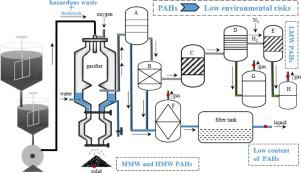Journal of Environmental Chemical Engineering ( IF 7.4 ) Pub Date : 2020-08-01 , DOI: 10.1016/j.jece.2020.104312 Xuebing Li , Li Li , Yuying Du , Meijia Liu , Qifei Huang , Jinzhong Yang , Lianghua Tang , Dahai Yan

|
Chemical industrial kilns were found to be used for waste treatment, however it is still in the research stage. In our study, field tests were conducted to find the emission and distribution characteristics of polycyclic aromatic hydrocarbons (PAHs) during co-processing of hazardous waste in an industrial scale coal-water slurry gasifier (CWSG), which is applied to ammonia production. Changes of temperature, pressure and gas production of CWSG were recorded under both blank condition (i.e., regular production) and test condition (i.e., feedstock mixed with hazardous waste). Concentration of PAHs in all the solid waste, waste water, and exhaust gas under two conditions were analyzed. Results showed that co-processing of hazardous waste has little impact on the operation stability of CWSG, the temperature were ranged at 1330–1350 ℃ in CWSG, the pressure and gas production were stabled at 1.0–1.3 MPa and 12000–14000 Nm3/h respectively. Low environmental risks of PAHs in regular production and weren’t increased by the addition of hazardous waste. Distribution trends of PAHs with different molecular weights in solid-liquid-gas three phases were basically the same under both two conditions. 92.96%−93.68% low molecular weights (LMW, 2–3rings) PAHs distributed in exhaust gas, 50.84%−71.66% middle molecular weights (MMW, 4 rings) PAHs distributed in solid waste, and 85.3%−86.77% high molecular weight (HMW, 5–6 rings) PAHs distributed in solid waste, while the content of PAHs in waste water was generally low.
中文翻译:

用于共处危险废物的化学工业窑炉:多环芳烃(PAHs)的环境风险低
已发现化学工业窑炉可用于废物处理,但仍处于研究阶段。在我们的研究中,进行了现场测试,以发现在工业规模水煤浆气化炉(CWSG)的危险废物协同处理过程中多环芳烃(PAHs)的排放和分布特征,该装置用于制氨。在空白条件(即常规生产)和测试条件(即原料与危险废物混合)下,记录了CWSG的温度,压力和产气量的变化。分析了两种条件下所有固体废物,废水和废气中PAHs的浓度。结果表明,危险废物的共处理对水煤浆的运行稳定性影响不大,水煤浆的温度范围为1330〜1350℃,3 /小时。常规生产中多环芳烃的低环境风险,但不会因添加危险废物而增加。两种条件下,固液气三相中不同分子量的多环芳烃的分布趋势基本相同。分布在废气中的低分子量PAHs为92.96%−93.68%(LMW,2-3个环),固体废物中分布的PAHs为50.84%−71.66%(MMW,4个环),高分子量为85.3%−86.77% (HMW,5–6个环)PAHs分布在固体废物中,而废水中的PAHs含量通常较低。











































 京公网安备 11010802027423号
京公网安备 11010802027423号